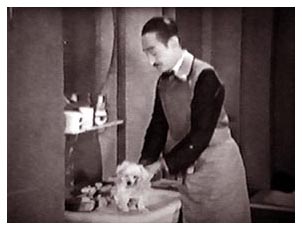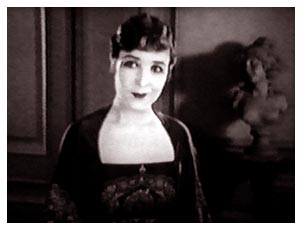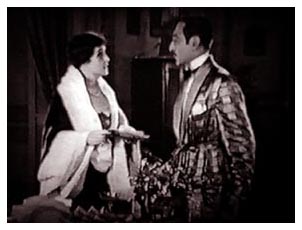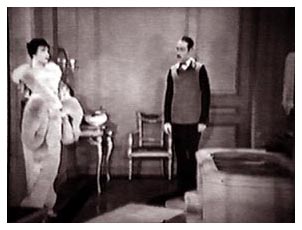

Famous Players-Lasky
Directed by Malcolm St. Clair
Released: February 21, 1926
55 minutes
CAST:
Adolphe Menjou (Albert Belfort), Florence Vidor (Grand Duchess
Zenia), Lawrence Grant (Grand Duke Peter), André Beranger
(Grand Duke Paul), Dot Farley (Prascovia), Barbara Pierce (Maxine),
Brandon Hurst (Matard), William Courtright (Charles, the valet)
Albert Durant is a man-about-town in Paris
juggling several women in one night to satisfy his playboy habits.
However, one night at the theatre, he spies a beautiful lady and
 follows her back to her hotel only to learn
she is the Grand Duchess Zenia of Russia accompanied by two Dukes
(Peter and Paul) and a lady-in-waiting (Prascovia). Since she
has retained an entire floor of the hotel, he secures the rooms
directly below hers. He gets the idea to pose as her waiter, but
is sorely inept, spilling cream on her and touching or addressing
her when such presumptuousness is unheard of from a waiter. To
teach him a lesson, she makes him one of her staff giving him
menial, degrading duties - even ordering him to sleep on the mat
at her bedroom door. He is so in love with her that this only
brings him delight. He soon learns, though, that the Duchess is
broke and cannot even pay her hotel bill. Since Albert is a millionaire,
he slips money in her purse and in the wallets of Peter and Paul.
She is aware of his attraction to her - and even feels an attraction
to him - but the idea of falling in love with a waiter is unthinkable.
Can she stop herself from falling in love with this man, and will
he ever reveal to her that he is a millionaire?
follows her back to her hotel only to learn
she is the Grand Duchess Zenia of Russia accompanied by two Dukes
(Peter and Paul) and a lady-in-waiting (Prascovia). Since she
has retained an entire floor of the hotel, he secures the rooms
directly below hers. He gets the idea to pose as her waiter, but
is sorely inept, spilling cream on her and touching or addressing
her when such presumptuousness is unheard of from a waiter. To
teach him a lesson, she makes him one of her staff giving him
menial, degrading duties - even ordering him to sleep on the mat
at her bedroom door. He is so in love with her that this only
brings him delight. He soon learns, though, that the Duchess is
broke and cannot even pay her hotel bill. Since Albert is a millionaire,
he slips money in her purse and in the wallets of Peter and Paul.
She is aware of his attraction to her - and even feels an attraction
to him - but the idea of falling in love with a waiter is unthinkable.
Can she stop herself from falling in love with this man, and will
he ever reveal to her that he is a millionaire?
The reviewer for Motion Picture Magazine (May, 1926) wasn't enamored with "The Grand Duchess and the Waiter" (1926). "This new tidbit of humor is almost as thin as vapor. . . There are times when it becomes quite silly and inane, and if you judge it too closely, it has its faults."
However, Photoplay (April, 1926) said, "A dramatic bonbon that will not improve your mind nor help you hold your husband nor solve how to pay the mortgage. But how it will delight you if you belong to that class which finds an unlifted eyebrow more stimulating than a heaving chest."
The praise continued with Variety's (February 10, 1926) opinion. "A nice, light comedy and likely to get good money wherever shown." In a rare moment of praise, The New York Times (February 9, 1926) reviewer said, "An enticing entertainment in which dull moments are conspicuous by their absence . . . it must be admitted that it caused no little laughter yesterday afternoon at the Mark Strand."
Photoplay probably said it best when it described "The Grand Duchess and the Waiter" as a "bonbon." To continue the dessert analogy, let's just say that it's not a banana split with all the toppings, but it is a better than average source of sweet pleasure for the entire 54 minutes of its running time.
Filmmakers and moviegoers were fascinated with royalty in the 1920's as evidenced by the number of films that involve kings, queens, princes, and princesses, or were set in either real or mythical kingdoms - "Graustark" (1925), "Just Suppose" (1926), "The Duchess of Buffalo" (1926), "The Merry-Go-Round" (1923), "The Merry Widow" (1925), "The Prisoner of Zenda" (1922), "Queen Kelly" (1928), "A Sailor-Made Man" (1921), "The Student Prince in Old Heidelberg" (1927), "The Wedding March" (1928) - and this list only scratches the surface. "The Grand Duchess and the Waiter" continues in that vein of interest which reached its peak after the marriages of Gloria Swanson and Mae Murray to princes. What really seemed to appeal to viewers was a prince/princess, duke/duchess or king/queen who came to America and was broke due to some uncontrollable situation in his or her home country. Florence Vidor's duchess is just such a character. To add humor to the situation, she has two relatives - Duke Peter, a cousin, and Duke Paul, her uncle - who only complicate her financial woes. The cousin is overly fond of vintage wines, and the uncle has a penchant for expensive cigars. Both of these are adding to a hotel bill that the Duchess already can't pay.
Admittedly, there is nothing new in the
make-up of this story. We have a millionaire playboy (Menjou)
who suddenly ceases to chase women when he finds the  girl
of his dreams. And, we have a Duchess who is broke because she
cannot return to her country while there's a revolution still
in full swing. Nothing new there. Also, we have a millionaire
posing as a lowly waiter - which complements nicely the fact that
the Duchess is broke - and he must win her love with the "poverty"
handicap while keeping his riches a secret. There is the love-hate
relationship that we enjoy so much, too - how many times have
we seen this kind of interplay between a man and a woman in our
entertainment? Even today's TV sitcoms have seen the value of
this type of boy-girl relationship. One of the maxims that all
such stories must follow, though, is that the one being pursued
(in this case the Duchess) must fall in love with the pursuer
(Menjou as the waiter) BEFORE learning of his wealth or we would
never be sure if it is really love or just greed.
girl
of his dreams. And, we have a Duchess who is broke because she
cannot return to her country while there's a revolution still
in full swing. Nothing new there. Also, we have a millionaire
posing as a lowly waiter - which complements nicely the fact that
the Duchess is broke - and he must win her love with the "poverty"
handicap while keeping his riches a secret. There is the love-hate
relationship that we enjoy so much, too - how many times have
we seen this kind of interplay between a man and a woman in our
entertainment? Even today's TV sitcoms have seen the value of
this type of boy-girl relationship. One of the maxims that all
such stories must follow, though, is that the one being pursued
(in this case the Duchess) must fall in love with the pursuer
(Menjou as the waiter) BEFORE learning of his wealth or we would
never be sure if it is really love or just greed.
So, if the story uses familiar themes that we've seen so many times, what makes this film special? Two things - the actors and the director. First let's talk about the actors. Menjou and Vidor are flawless in their roles. Menjou exudes the sophistication of the French millionaire/playboy with a naturalness that few others could portray. His love for the Duchess is genuine and expressed with subtlety and economy of gesture. Vidor was also an actress who could stand still and portray sophistication. Her aloofness with Menjou comes across in full force, yet not once does she purse her lips or turn up her nose to characterize her detachment. Coupled with this, though, she must let the audience know - very slowly at first - that she likes this man. She does this early on in the film after he accidentally spills cream over her shoulder and all down the front of her dress. She returns from cleaning up and changing her clothes to see Menjou, as the waiter, turning the creamer from side to side and looking at it from every angle, obviously in disbelief at his clumsiness. Vidor barely turns up one side of her mouth in a half smile, but the audience clearly gets its first message that she is not entirely cold toward our hero. The gesture also "humanizes" her in our eyes, and we begin to like her more and more. After all, a basic rule of story-telling must be met. We will never be satisfied with the union of two lovers unless we, as an audience, love them both first!
The reviewers all agreed - the actors are the life-blood of this film. "It is the talents of Adolph (sic) Menjou and Florence Vidor shining forth from it like bubbles in champagne that make it the delicious thing it is," said Photoplay.
"Another good Menjou vehicle and, consequently, another step up the ladder for this comedian, whose screen vehicles all deal with his lady-killing abilities. . . With Florence Vidor as the duchess and a fine cast supporting, the acting part moves well and swiftly," said the Variety reviewer.
The New York Times had praise for all of the actors. "The idea of having Adolphe Menjou in as the leading male part and Florence Vidor in the role of the Duchess decidedly suits this photoplay. Miss Vidor, who has large brown eyes, a small and peculiarly attractive mouth and a well-sheared Eton bob, is refreshing as the Grand Duchess. . . Mr. Menjou surpasses himself in many of the scenes. By a mere raising of his eyebrows he is able to stir up peals of laughter. He is never really abashed except possibly when he is caught with a maid's head reposing on his unwilling shoulder. He is wonderfully clever in the periods where the Grand Duchess calls for him, especially when he supposed that she is in her bath. . . André Beranger and Lawrence Grant are amusing as the two Grand Dukes. William Courtright is splendid as Blake (sic), Albert's faithful valet."

The second thing that makes this film so special is director Malcolm St. Clair. He had worked with both Mack Sennett and Buster Keaton, so his comedy credentials are superb. However, his directorial efforts didn't mimic either one of these. Instead there was a style and sophistication to his direction that led writers to label him as "the second Lubitsch." Of course, that could be attributed to anyone who directed a comedy of manners - particularly when words such as Parisian, sophistication, and bedroom are associated with them. St. Clair's directorial efforts that home viewers can see today -- such as "Are Parents People?" (1925) with Betty Bronson and Menjou, "The Show Off" (1926) with Ford Sterling and Louise Brooks, or "Welcome Danger" (1929) with Harold Lloyd -- certainly wouldn't be considered films that mimic the "Lubitsch touch." Nevertheless, the comment is still a tribute to the classy style St. Clair could give to his comedies.
For example, there is an excellent camera angle in the theatre sequence at the beginning of the movie. Albert enters the box where his three friends are waiting. Rather than a simple long shot of the box, the camera shoots from a low angle on the stage showing the box in the distance and the legs of the ballet dancer pirouetting near us on the right side of the frame. This clearly tells us what's taking place in the theatre at the time while indicating Albert's tardiness and adding a certain "sexiness" by emphasizing only the legs of the dancer.
In another scene, Albert comes into the Duchess' suite to find her in a large chair, resting with her eyes closed. He turns his back for just a moment, and we see the Duchess' eyes open - she knows he's there. Just as he turns back to face her, she quickly closes her eyes again. This time he falls to one knee before her and places one hand over his heart and the other outstretched as if to propose - a mildly anxious moment for the viewer as we wonder if she will catch him enacting this tender gesture of devotion. Then, surprisingly, he leans forward to kiss the top of her foot! Just at the moment he bends over, she does opens her eyes and, caught by surprise, kicks! Albert falls backward clutching his mouth and nose while the Duchess jumps up to berate this "impertinent scoundrel!" Throughout the film, St. Clair handles Albert's infatuation in a very subdued and well-paced manner, and this scene, in which the depth of his love and devotion are shown by kissing her foot, turns out to be an elegant touch, as well as a comedic surprise!
St. Clair does a superb job of teasing the
viewer in possibly the most sexually suggestive scene in the movie.
(Don't read this paragraph if you'd rather be surpised when
you see the movie!) The maid has just returned from assisting
the Duchess prepare her bath. As Albert and the maid talk in the
next room, we are shown a head shot of the Duchess shouting "Albert!"
from the bathroom. Albert looks at the maid in disbelief and flatly
refuses to go. We see the same shot again of the Duchess as she
calls, "Albert!!" but he still refuses to go even though
the maid insists that he better. This continues at least twice
more before Albert finally gives in. With great apprehension -
and eyes closed - he opens the bathroom door and walks in. We
see him standing there with eyes still tightly shut and the Duchess
off to the side standing, fully clothed in a dressing gown with
a huge fur collar. Albert slowly opens his eyes and sees a bathtub
filled with water . . . and nothing else! She has called him in
to retrieve her book that fell in the water - another menial,
degrading task that he must perform. However, for just a few moments,
St. Clair has the viewer unsure of what Albert's going to see
 when he enters the bathroom and, without a
doubt, he also has the viewer's complete, undivided attention
throughout the scene!
when he enters the bathroom and, without a
doubt, he also has the viewer's complete, undivided attention
throughout the scene!
St. Clair, too, was universally praised by the critics for his direction of this movie. Photoplay said, "Malcolm St. Clair has directed it flawlessly. Another picture of this caliber from this young man and his will be a name well worth following to any box office." According to Motion Picture Magazine, "It . . . speaks volumes for St. Clair who knows how to season a dish after the Lubitsch manner." "Mal St. Clair's direction is corking and his celebrated 'light touch' is in evidence many times," said Variety, and The New York Times continued the praise, "There are not a few brilliant streaks in this Parisian farce-comedy, which was directed by Malcolm St. Clair, whose last piece of work was Pola Negri's 'A Woman of the World.' Needless to say this is a far superior picture, one in which Mr. St. Clair does not enlist Mack Sennett ideas to bolster up his comedy."
The running time on the print viewed was 55 minutes, however the length at the time of release is listed at 6,314 feet, or what should have been approximately 63 minutes. So, it would appear there could be as much as eight minutes missing from the Grapevine DVD. What did these eight minutes contain? It is impossible to tell from this print since it appears to be complete in all respects. The projection speed looks to be appropriate, and there is no evidence of missing intertitles. All in all, it's a very good print - apparently with original tints, good contrast (only a few brief shots where there is "over-contrast") and nice clarity. As usual, David Knudtson does a good organ score for the film, too. There was a print of this film available for home viewing on VHS in years past, but the quality of Grapevine's DVD is far superior to the other company's release and also contains a very humorous scene (walking the dogs) that was not in the VHS release.
Photoplay completed its review by saying, "Sophistication and sex at their merriest are here. Yet so beautifully is it all handled it is safe for everyone from grandma down to the baby." Yes, the sophistication is here - as it always is when the much underrated Adolphe Menjou is present. However, the sex is minimal, and what is there is tastefully and subtly done. As for "merry" and "beautifully handled," that aptly describes the film from the opening titles until "Finis" is flashed on the screen.
Copyright 2017 by Tim Lussier. All rights reserved.